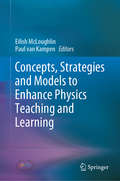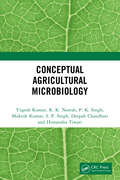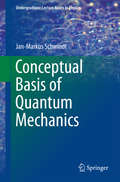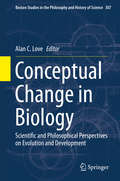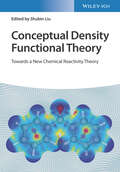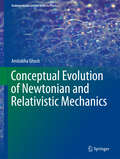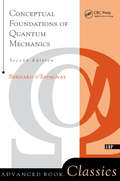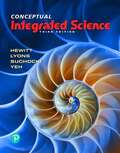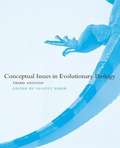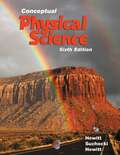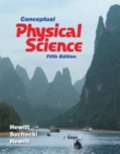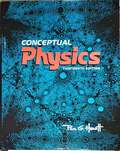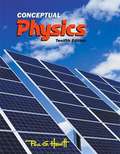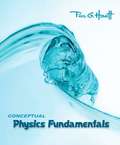- Table View
- List View
Concepts, Strategies and Models to Enhance Physics Teaching and Learning
by Eilish McLoughlin Paul Van KampenThis book discusses novel research on and practices in the field of physics teaching and learning. It gathers selected high-quality studies that were presented at the GIREP-ICPE-EPEC 2017 conference, which was jointly organised by the International Research Group on Physics Teaching (GIREP); European Physical Society – Physics Education Division, and the Physics Education Commission of the International Union of Pure and Applied Physics (IUPAP). The respective chapters address a wide variety of topics and approaches, pursued in various contexts and settings, all of which represent valuable contributions to the field of physics education research. Examples include the design of curricula and strategies to develop student competencies—including knowledge, skills, attitudes and values; workshop approaches to teacher education; and pedagogical strategies used to engage and motivate students. This book shares essential insights into current research on physics education and will be of interest to physics teachers, teacher educators and physics education researchers around the world who are working to combine research and practice in physics teaching and learning.
Conceptual Agricultural Microbiology
by Mukesh Kumar S. P. Singh P. K. Singh Yogesh Kumar R. K. Naresh Deepak Chaudhari Himanshu TiwariThis book integrates microbiology with soil science, chemistry, and ecology to analyse the functions of microorganisms in the soil environment. It covers the status and application of microbiology in modern agriculture and discusses various fundamental allied concepts.The subject matter in this book also details – Microorganism groups Industrial Microbiology Biotechnology and Genetic Engineering Environmental Microbiology Nutritional Media and their Preparations Print edition not for sale in South Asia (India, Sri Lanka, Nepal, Bangladesh, Pakistan and Bhutan)
Conceptual Basis of Quantum Mechanics (Undergraduate Lecture Notes in Physics)
by Jan-Markus SchwindtThe book covers the content of a typical higher undergraduate course of the theory of Quantum Mechanics. The focus is on the general principles of quantum mechanics and the clarification of its terminology: What exactly is a Hilbert space? What is a hermitean operator? A tensor product? An entangled state? In what sense does a wave function constitute a vector? A separate chapter discusses the many open questions regarding the interpretation of the postulates.
Conceptual Biomechanics and Kinesiology
by Animesh Hazari Arun G. Maiya Taral V. NagdaThis book presents essential information on the various concepts of biomechanics and kinesiology applied to human body, also describing in depth the understanding of the various physical and mathematical principles applied towards understanding of this science of movement. It tries to simplify this biological movement science by facilitating easy understanding of the various applications of the forces acting on the human body. This book provides a deep insight to the clinical gait analysis and it’s interpretations with graphical outputs, it also covers important topics such as biomechanics of important human joints such as neck, shoulder, spine, hip, knee and ankle with their recent advances. It also includes chapters on biomechanical instrumentation and their interpretation. Another highlight of the book is chapters on biomechanical motion analysis systems used for athletes. This book offers a valuable resource for medical and paramedical students, researchers and clinicians practicing musculoskeletal and manual therapy, aiding researchers gaining insight to human biomechanics.
Conceptual Change in Biology: Scientific and Philosophical Perspectives on Evolution and Development (Boston Studies in the Philosophy and History of Science #307)
by Alan C. LoveThis volume explores questions about conceptual change from both scientific and philosophical viewpoints by analyzing the recent history of evolutionary developmental biology. It features revised papers that originated from the workshop "Conceptual Change in Biological Science: Evolutionary Developmental Biology, 1981-2011" held at the Max Planck Institute for the History of Science in Berlin in July 2010. The Preface has been written by Ron Amundson. In these papers, philosophers and biologists compare and contrast key concepts in evolutionary developmental biology and their development since the original, seminal Dahlem conference on evolution and development held in Berlin in 1981. Many of the original scientific participants from the 1981 conference are also contributors to this new volume and, in conjunction with other expert biologists and philosophers specializing on these topics, provide an authoritative, comprehensive view on the subject. Taken together, the papers supply novel perspectives on how and why the conceptual landscape has shifted and stabilized in particular ways, yielding insights into the dynamic epistemic changes that have occurred over the past three decades. This volume will appeal to philosophers of biology studying conceptual change, evolutionary developmental biologists focused on comprehending the genesis of their field and evaluating its future directions, and historians of biology examining this period when the intersection of ev olution and development rose again to prominence in biological science.
Conceptual Chemistry: Understanding Our World of Atoms and Molecules (3rd edition)
by John SuchockiThis book presents chemistry conceptually, focusing on the concepts of chemistry with little emphasis on calculations. Though sometimes wildly bizarre, the concepts of chemistry are straightforward and accessible-all it takes is the desire to learn.
Conceptual Density Functional Theory: Towards a New Chemical Reactivity Theory
by Shubin LiuConceptual Density Functional Theory A unique resource that combines experimental and theoretical qualitative computing methods for a new foundation of chemical reactivity This two-volume reference book shows how conceptual density functional theory can reconcile empirical observations within silico calculations using density functional theory, molecular orbital theory, and valence bond theory. The ability to predict properties like electronegativity, acidity/basicity, strong covalent and weak intermolecular interactions as well as chemical reactivity makes DFT directly applicable to almost all problems in applied chemistry, from synthetic chemistry to catalyst design and materials characterization. Edited by one of the most recognized experts in the field and contributed to by a panel of international experts, the work addresses topics such as: Qualitative methods that are capable of rationalizing chemical concepts derived from theory and computation Fundamental concepts like the computation of chemical bonding, weak interactions, and reactivity Computational approaches for chemical concepts in excited states, extended systems, and time-dependent processes Theoretical chemists and physicists, as well as those applying theoretical calculations to empirical problems, will be able to use this book to gain unique insight into how theory intersects with experimental data in the field of qualitative computation.
Conceptual Evolution of Newtonian and Relativistic Mechanics (Undergraduate Lecture Notes in Physics)
by Amitabha GhoshThis book provides an introduction to Newtonian and relativistic mechanics. Unlike other books on the topic, which generally take a 'top-down' approach, it follows a novel system to show how the concepts of the 'science of motion' evolved through a veritable jungle of intermediate ideas and concepts. Starting with Aristotelian philosophy, the text gradually unravels how the human mind slowly progressed towards the fundamental ideas of inertia physics. The concepts that now appear so obvious to even a high school student took great intellectuals more than a millennium to clarify. The book explores the evolution of these concepts through the history of science. After a comprehensive overview of the discovery of dynamics, it explores fundamental issues of the properties of space and time and their relation with the laws of motion. It also explores the concepts of spatio-temporal locality and fields, and offers a philosophical discussion of relative motion versus absolute motion, as well as the concept of an absolute space. Furthermore, it presents Galilean transformation and the principle of relativity, inadequacy of Galilean relativity and emergence of the spatial theory of relativity with an emphasis on physical understanding, as well as the debate over relative motion versus absolute motion and Mach's principle followed by the principle of equivalence. The natural follow-on to this section is the physical foundations of general theory of relativity. Lastly, the book ends with some new issues and possibilities regarding further modifications of the laws of motion leading to the solution of a number of fundamental issues closely connected with the characteristics of the cosmos. It is a valuable resource for undergraduate students of physics, engineering, mathematics, and related disciplines. It is also suitable for interdisciplinary coursework and introductory reading outside the classroom.
Conceptual Foundations Of Quantum Mechanics: Second Edition
by Bernard D'EspagnatConceptual Foundations of Quantum Mechanics provides a detailed view of the conceptual foundations and problems of quantum physics, and a clear and comprehensive account of the fundamental physical implications of the quantum formalism. This book deals with nonseparability, hidden variable theories, measurement theories and several related problems. Mathematical arguments are presented with an emphasis on simple but adequately representative cases. The conclusion incorporates a description of a set of relationships and concepts that could compose a legitimate view of the world.
Conceptual Integrated Science
by Paul G. Hewitt John A. Suchocki Jennifer Yeh Suzanne A LyonsConceptual Integrated Science connects ideas across the sciences with an engaging overview of physics, chemistry, earth science, astronomy and biology, at a level appropriate for non-science students. Author Paul Hewitt's engaging narrative emphasizes unifying concepts across physical and life sciences in a clear, friendly writing style with fun, relevant examples. The 3rd Edition expands on the theme of integration, deepening connections between the sciences with Integrated Science spreads. Updated Technology boxes feature modern references and contemporary applications that add relevance to help you connect science with your everyday life.
Conceptual Integrated Science
by Paul G. HewittThis book will change the way you look at science. Written by best-selling author Paul Hewitt, Conceptual Integrated Science is more than a collection of facts-it's a guidebook for understanding the world around you. Using his successful "concepts first" method, accessible writing, and fun and informative illustrations, Hewitt and his team of science experts have crafted a text that focuses on unifying concepts and real-life examples across physics, chemistry, earth science, biology, and astronomy. <p><p> The book includes Hewitt's effective teaching method, straight-forward learning features, approachable style, and rigorous coverage. The result is a wide-ranging science text that is uniquely effective and motivational. Conceptual Integrated Science is accompanied by an unparalleled media package that combines Interactive Tutorials, Interactive Figures, and renowned demonstration videos to help you outside of class.
Conceptual Integrated Science Explorations (Florida Edition)
by John Suchocki Paul G. Hewitt Suzanne LyonsScience textbook for Florida students.
Conceptual Integrated Science--explorations
by Paul HewittFrom the author of the number one textbooks in physical science and physics comes the eagerly awaiting new text, Conceptual Integrated Science. Hewitt's critically acclaimed conceptual approach has led science education for 30 years and now tackles integrated science to take student learning to a new level. Using his proven conceptual approach, accessible writing, and fun and informative illustrations, Hewitt and his team of science experts have crafted a text that focuses on the unifying concepts and real-life examples across physics, chemistry, earth science, biology, and astronomy.The book includes best-selling author Paul Hewitt's proven pedagogical approach, straight-forward learning features, approachable style, and rigorous coverage. The result is a wide-ranging science text that is uniquely effective and motivational. Conceptual Integrated Science is accompanied by an unparalleled media package that combines interactive tutorials, interactive figures, and renowned demonstration videos to help students outside of class and instructors in class.
Conceptual Issues in Evolutionary Biology
by Elliott SoberThese essays by leading scientists and philosophers address conceptual issues that arise in the theory and practice of evolutionary biology. The third edition of this widely used anthology has been substantially revised and updated. Four new sections have been added: on women in the evolutionary process, evolutionary psychology, laws in evolutionary theory, and race as social construction or biological reality. Other sections treat fitness, units of selection, adaptationism, reductionism, essentialism, species, phylogenetic inference, cultural evolution, and evolutionary ethics. Each of the twelve sections contains two or three essays that develop different views of the subject at hand. For example, the section on evolutionary psychology offers one essay by two founders of the field and another that questions its main tenets. One sign that a discipline is growing is that there are open questions, with multiple answers still in competition; the essays in this volume demonstrate that evolutionary biology and the philosophy of evolutionary biology are living, growing disciplines. ContributorsRobin O. Andreasen, Kwame Anthony Appiah, David A. Baum, John H. Beatty, David J. Buller, Leda Cosmides, James Donoghue, Steven J. Farris, Joseph Felsenstein, Susan K. Finsen, Joseph Fracchia, Stephen Jay Gould, Sarah Blaffer Hrdy, David L. Hull, Philip Kitcher, R. C. Lewontin, Elisabeth Lloyd, Ernst Mayr, Michael Ruse, John Maynard Smith, Elliott Sober, John Tooby, C. Kenneth Waters, George C. Williams, David Sloan Wilson, E. O. Wilson
Conceptual Physical Science
by John Suchocki Paul G. Hewitt Leslie A. HewittConceptual Physical Science, Second Edition, with its important ancillaries, provides a first introduction to physics, chemistry, earth science, and astronomy, melded in a manner to captivate student interest.
Conceptual Physical Science
by John Suchocki Paul Hewitt Leslie HewittConceptual Physical Science, Sixth Edition, provides a conceptual overview of basic, essential topics in physics, chemistry, earth science, and astronomy with optional quantitative analyses. The authors focus on concepts before computations. With its clear, friendly writing style, and strong integration of the sciences, this book connects well with all students.
Conceptual Physical Science (Fifth Edition)
by Paul G. Hewitt Leslie A. Hewitt John A. SuchockiConceptual Physical Science, Fifth Edition, takes learning physical science to a new level by combining Hewitt's leading conceptual approach with a friendly writing style, strong integration of the sciences, more quantitative coverage, and a wealth of media resources to help professors in class, and students out of class. It provides a conceptual overview of basic, essential topics in physics, chemistry, earth science, and astronomy with optional quantitative coverage.
Conceptual Physical Science: Explorations
by John Suchocki Paul G. Hewitt Leslie A. HewittPhysics textbook for high school and college.
Conceptual Physical Science: Explorations
by John Suchocki Paul G. Hewitt Leslie A. HewittTextbook on physical science.
Conceptual Physical Science: Explorations (2nd Edition)
by Paul G. Hewitt Leslie A. Hewitt John A. SuchockiConceptual Physical Science: Explorations introduces physical science to students using a conceptual approach. It melds physics, chemistry, Earth science, and astronomy, in a manner that captivates student interest. This second edition of CPSE is a major upgrade from the first edition. In addition to a smoother flow of topics and updates to scientific advances (especially in astronomy) numerous new and exciting features are designed to help students learn most efficiently.
Conceptual Physics
by Paul G. HewittConceptual Physics, Tenth Edition helps readers connect physics to their everyday experiences and the world around them with additional help on solving more mathematical problems. Hewitt's text is famous for engaging readers with analogies and imagery from real-world situations that build a strong conceptual understanding of physical principles ranging from classical mechanics to modern physics. With this strong foundation, readers are better equipped to understand the equations and formulas of physics, and motivated to explore the thought-provoking exercises and fun projects in each chapter. Included in the package is the workbook. Mechanics, Properties of Matter, Heat, Sound, Electricity and Magnetism, Light, Atomic and Nuclear Physics, Relativity. For all readers interested in conceptual physics.
Conceptual Physics
by Paul G. HewittConceptual Physics 13e with Modified Mastering Physics with Pearson eText
Conceptual Physics (12th Edition)
by Paul G. HewittConceptual Physics with MasteringPhysics® , Twelfth Edition Paul Hewitt integrates a compelling text and the most advanced media to make physics interesting, understandable, and relevant for non-science majors. The Twelfth Edition will delight you with informative and fun Hewitt-Drew-It screencasts, updated content, applications, and new learning activities in MasteringPhysics.<p><p> Hewitt’s text is guided by the principle of "concepts before calculations" is famous for engaging students with analogies and imagery from the real-world that build a strong conceptual understanding of physical principles ranging from classical mechanics to modern physics.<p> This program presents a better teaching and learning experience–for you.<br> - Personalize learning with MasteringPhysics: MasteringPhysics provides you with engaging experiences that coach you through physics with specific wrong-answer feedback, hints, and a huge variety of educationally effective content.<br> - Prepare for lecture: NEW! 100 Hewitt-Drew-It screencasts, authored and narrated by Paul Hewitt, explain physics concepts through animation and narration. The exciting new Screencasts, accessed through QR codes in the textbook, will enable you to engage with the physics concepts more actively outside of class.<br> - Make physics delightful: Relevant and accessible narrative, analogies from real-world situations, and simple representations of the underlying mathematical relationships make physics more appealing.<br> - Build a strong conceptual understanding of physics: You will gain a solid understanding of physics through practice and problem solving in the book and in MasteringPhysics.
Conceptual Physics Fundamentals
by Paul G. Hewitt Phillip R. WolfFrom Paul G. Hewitt, author of the market-leading Conceptual Physics, comes his eagerly awaited new, briefer, alternative text, Conceptual Physics Fundamentals. The text extends best-selling author Paul Hewitt's proven pedagogical approach, straight-forward learning features, approachable style, and rigorous coverage, while providing superior supplements and media. The book develops a solid conceptual understanding of physics, while building readers' self-confidence applying their understanding quantitatively. About Science, Equilibrium and Linear Motion, Newton's Laws of Motion, Momentum and Energy, Gravity, Projectiles, and Satellites, Fluid Mechanics, Temperature, Heat, and Thermodynamics, Heat Transfer and Change of Phase, Electrostatics and Electric Current, Magnetism and Electromagnetic Induction, Waves and Sound, Light waves, Properties of Light, Atoms, Quantum Theory, The Atomic Nucleus and Radioactivity. For all readers interested in conceptual physics.
